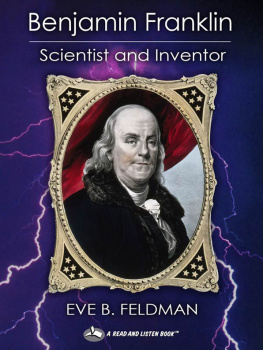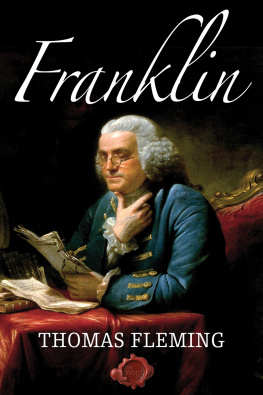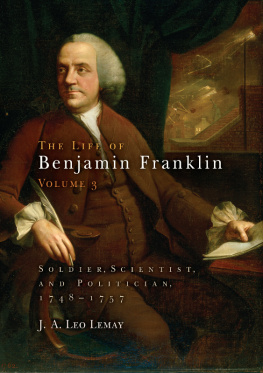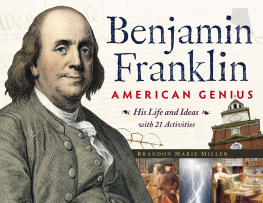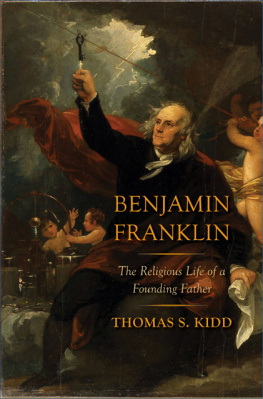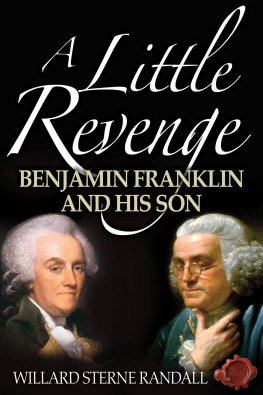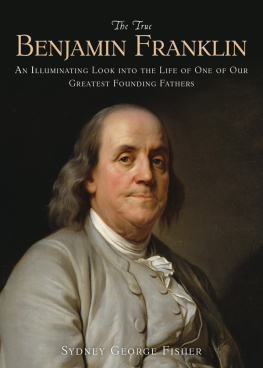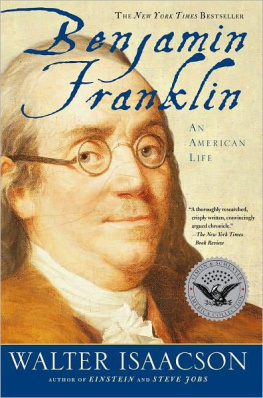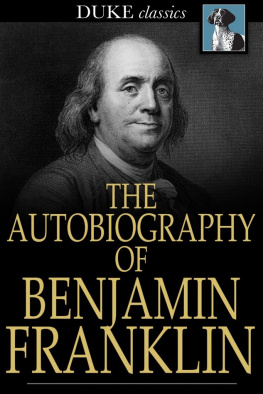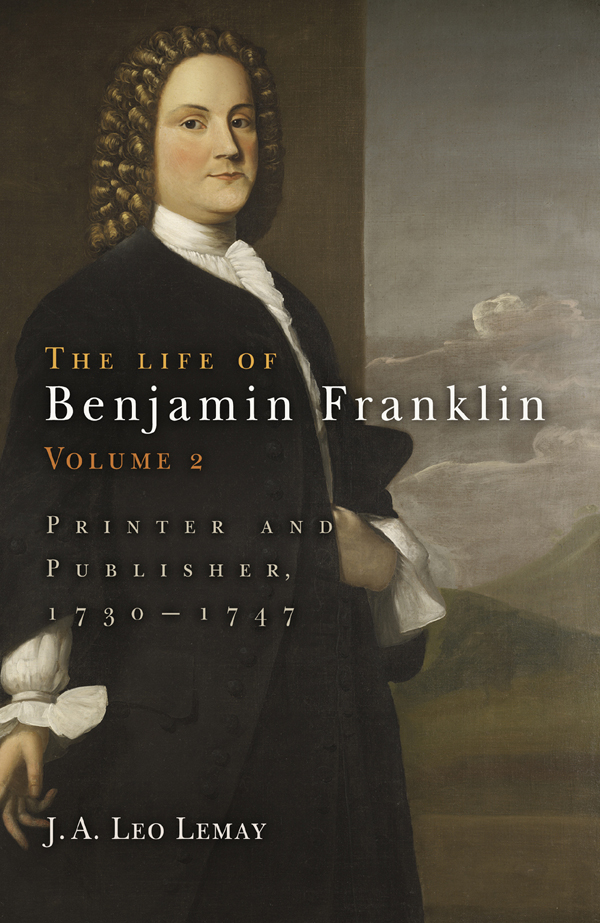The Life of Benjamin Franklin VOLUME TWO

The Life of Benjamin Franklin
VOLUME TWO
Printer and Publisher
17301747
J. A. L EO L EMAY

Copyright 2006 University of Pennsylvania Press
All rights reserved
Printed in the United States of America on acid-free paper
10 9 8 7 6 5 4 3 2
Published by
University of Pennsylvania Press
Philadelphia, Pennsylvania 19104-4112
Library of Congress Cataloging-in-Publication Data
Lemay, J. A. Leo (Joseph A. Leo), 1935
The life of Benjamin Franklin / J. A. Leo Lemay.
p. cm.
Includes bibliographical references and index.
Contents: v. 1. Journalist, 17061730v. 2. Printer and publisher, 17301747
ISBN 0-8122-3854-0 (v. 1 : acid-free paper).ISBN 0-8122-3855-9 (v. 2 : acid-free paper)
1. Franklin, Benjamin, 17061790. 2. StatesmenUnited StatesBiography.
3. ScientistsUnited StatesBiography. 4. InventorsUnited StatesBiography. 5.
PrintersUnited StatesBiography. I. Title.
E302.6.F8L424 2005
973.392dc22
[B]
2004063130
Frontispiece: Benjamin Franklin (1745 or 1746) by Robert Feke. Franklins older brother John (16901756) commissioned the first portrait of Franklin, and he displayed it as a companion piece to his own portrait in his Boston home. Franklin probably chose how to present himself. His wig is brown, comparatively short and simple, and the coat and pants are plain. A gentleman or a professional man would typically be portrayed wearing a more elaborate, longer, white wig and a more ornamental jacket. The portrait suggests that the subject is a successful tradesman, a member of the middling sort. Courtesy, Harvard University Portrait Collections, bequest of Dr. John Collins Warren, 1856.
Endpapers: Map of Franklins Philadelphia, with key places of interest indicated. Reprinted from The Papers of Benjamin Franklin, ed. Leonard W. Labaree et al. (New Haven, Conn.: Yale University Press, 1959), vol. 2, facing p. 456. Courtesy, Ellen Cohn.
The biography as a whole is dedicated to
Ann C. Lemay, John C. Lemay, Lee C. Lemay, and Kate C. Lemay.
This volume is dedicated to a group of friends who were members of the Natural History Society of Maryland, 194757, especially Romeo Mansueti, John E. Cooper, Jack Delaney, Henry C. Eichhorn, Jr., Edmund B. Fladung, Joseph Gentile, John D. Glaser, Harold D. Levy, Anthony G. Marsiglia, Carl Pfeiffer,
James B. Toland, and Manfred Wasserman.
Contents
Illustrations
Franklins Philadelphia end papers
Benjamin Franklin by Robert Feke frontispiece
. Page 1 of Ledger A&B, Franklins earliest surviving account book.
. The first six Virtues enumerated in Franklins scheme for self-discipline, from the Autobiography.
. Infractions of Franklins scheme of thirteen virtues, from the Autobiography.
. Franklins chart showing how he tried to spend the time in a typical working day, from his Autobiography.
. Blackmailing the Masons? The Mystery of Free-Masonry, Pennsylvania Gazette, 8 December 1730.
. The Library Company seal, drawn by Nian-Sheng Huang from the impression made by Philip Syngs die.
. Blackamore, the second African American persona in American journalism, Pennsylvania Gazette, 30 August 1733.
. Condescending Englishmen Lampooned, Pennsylvania Gazette, 20 April 1732.
. The preface to Poor Richard for 1733, predicting the death of the rival almanac maker Titan Leeds.
. Poor Richards wife, Bridget, trashes her husbands preface and writes her own in Poor Richard for 1738.
. A Half-Hours Conversation with a Friend, the first interview in American journalism, Pennsylvania Gazette, 16 November 1733.
. The State House (Independence Hall), Philadelphia.
. A wedding anniversary song: Poor Richards Description of his Country Wife JOAN from Father Abrahams Speech (Boston: B. Mecom, [1758]).
. Music to the wedding anniversary song.
. Criticized by Franklin, Deborah writes an anguished shop book entry, 16 August 1737.
. A hat for Franklins slave, 1745.
. Words and music to Franklins song Fair Venus Calls from David Vinton, The Masonic Minstrel (Dedham, Mass.: H. Mann, 1816).
. The manuscript of Franklins drinking song (The Antediluvians Were All Very Sober).
. Charged with complicity in the hazing and death of Daniel Rees, Franklin defended himself in the Pennsylvania Gazette, 15 February 1737/8, p. 3.
. Franklins religion, described in a letter to his parents, 13 April 1738.
. Franklin influences the election of 1741: the first page of Governor George Thomass letter to the Lords of Trade (Philadelphia: B. Franklin, 1741).
. The site of the annual fight for the stairs at Philadelphias elections.
. A map of Louisbourg, Cape Breton, which the New England militia was attacking; the first map and illustrated news event in American journalism, Pennsylvania Gazette, 6 June 1745.
. Franklin celebrates Brave Men at Fires, Pennsylvania Gazette, 20 December 1733.
. Firefighters and fire-fighting equipment in the mid-eighteenth century.
. Postmasters waybill, designed by Franklin to organize postmasters accounts.
. Franklins New-Invented Pennsylvania Fireplace with its distinctive front plate, 1744.
. An Americanized version of a woodcut illustrating an Aesops fable, showing a Franklin stove in the fireplace, 1747.
. Crusading for a more equitable tax and better police: the title page of A Bill for the Better Regulating the Nightly Watch (1743).
. A failed environmental campaign, The Tanners of Philadelphia, Pennsylvania Gazette, 30 August 1739.
. Nature printing, a new technique to prevent counterfeiting.
. A magic square of 16.
. A magic circle, the first ever devised.
. New meteorological and electrical theories, engraved in Lewis Evans, Map of Pennsilvania, New-Jersey, New-York, and the Three Delaware Counties (1749).
. John Bartrams map of the Appalachian Mountains, showing rivers and the locations of seashells on mountains.
. Franklins manuscript containing eight reasons for preferring an old mistress to a young one, from Old Mistresses Apologue, 25 June 1745.
. The American text of The Speech of Miss Polly Baker, Maryland Gazette, 11 August 1747.
Preface
Volume 2 takes Franklin from his marriage in 1730 to his retirement as a printer at the very beginning of 1748, a few days after his forty-second birthday. William, Franklins illegitimate son, was born in 1728 or 1729, and the mystery of his unknown mother is discussed in connection with Franklins courtship and marriage. On 1 September 1730, Franklin and Deborah Read Rogers joined together in a common-law marriage because her husband, John Rogers, might still have been alive. They took William into their home and brought him up as their son. While Franklin printed on the second floor, Deborah managed the shop on the first, which at first sold legal forms, stationery, and common books, including almanacs, spellers, and Bibles. Gradually, the shop expanded and became a bookstore, stationery shop, and something akin to a general store. On 20 October 1732, Francis Folger Franklin was born, only to die of smallpox at age four. Eleven years after the birth of Francis, Franklin and Deborah had another child, Sarah, on 31 August 1743. By this time, Deborah had help with the house and with Sarah, and she continued to assist Franklin with the shop and his other enterprises. Deborah and the children attended Philadelphias Anglican Christ Church, where both Francis and Sarah were baptized and where Francis was buried.


